RENTON A BRIEF HISTORY from 1715 to 2008 - Page 2
Page 1 | Page 3 | Page 4 | Page 5
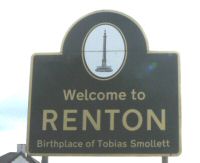 There was no male heir and the ownership passed to Tobias's sister, Jane, who had married a Mr Alexander Telfer. She adopted the style “Telfer Smollett” which the Smolletts have continued to use until this day. She lived at Dalquhurn House until she inherited Cameron in 1775. By then she had already played a key role in the history of Renton - she founded it in 1762, and named it after her daughter-in-law Cecilia Renton.
There was no male heir and the ownership passed to Tobias's sister, Jane, who had married a Mr Alexander Telfer. She adopted the style “Telfer Smollett” which the Smolletts have continued to use until this day. She lived at Dalquhurn House until she inherited Cameron in 1775. By then she had already played a key role in the history of Renton - she founded it in 1762, and named it after her daughter-in-law Cecilia Renton.
It was founded in response to the need for housing for the growing number of incomers working in the bleachfields. The Smolletts had no direct financial interests in any of the textile works in the Vale at any time, but they were the feu superior for most of the land on the west side of the Valley, and in the late 18th century still directly owned most of it. So there was plenty of money to be made by them out of property in general, and housing in particular. No doubt Mrs Telfer Smollett saw an opportunity for growing rental income in Renton from the outset, and with the opening of Cordale Works just 8 years after the foundation of the village, and the continuing success of William Stirling and Sons, she was certainly proved right about that.
As things turned out, there was a continuously increasing need for houses in the area, which was not really met until the 1960's. The layout of the village was very simple - two parallel roads running north and south - what is still Main St and Back Street - crossed by an increasing number of shortish streets running east - west from the banks of the Leven to the foot of the hill. In its earliest days the village extended from about the Smollett Monument to Red Row, and was centred on what became known as Renton Cross, i.e. where King Street and Burn Street intersected with Main Street.
With the exception of some large red sandstone villas on the lower slopes of the hillside built from 1870's - 90's, that layout remained the same until the southwards expansion of the village of the 1880s and the council housing additions of Tontine and Cordale in the 1920's - 40's. One of the north-south roads around which the village was built was already in place in 1762, and indeed still takes the line that it did then. Now it is called Main Street, and its southern extension was named Lennox Street in the 1880's, but when soldiers built it in 1746 - 48, it was simply known as the Dumbarton - Inverary military road. It had been planned in 1743 as part of the network of military roads to access the Highlands after the Jacobite revolts of 1715 and 1719, but was delayed by the much more serious Jacobite rebellion of 1745.
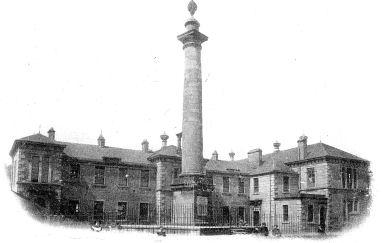
The Smollet Monument in Renton (Click to Enlarge)
It was in an open field beside this road, that James Smollett of Bonhill decided to erect a monument to his late cousin Tobias, and this, the Smollett Monument, is Renton and the Vale's pre-eminent monument. It was erected in 1774 on the site it has occupied ever since. The inscription on it is in English, and, at the insistence of Smollett's friend Doctor Johnson, Latin. Dr Johnson made his contribution to the inscription in 1773 when he visited James Smollett at Cameron House, (which James had bought and moved to from Place of Bonhill in 1763). In Johnson's opinion, the inscription shouldn't be wasted on any passing Highland drover, and should therefore be in Latin.
One of the immediate benefits to us of the Monument was that it quickly attracted the attention of an artist, and it is depicted on the first picture that we have of the Vale - an engraving from about 1777. The engraving looks south and probably intentionally excludes much of what would still have been a small village at the time. But it does show some very useful details - an inlet to the Dalquhurn lades from the Leven, the tow-path with a couple of horses pulling a sailing boat up the Leven, what is probably Dalquhurn House, and some other houses at Dalquhurn and beside the main road. In the background is Dumbarton Bridge and the three kilns of Dumbarton glassworks which stood beside the river in the general area of what is now Broadmeadow / the railway / the medical centre.
By the time of this engraving, Renton was already 15 years old and was growing. As we've seen, Cordale Printfield had opened on Cordale Point under William Stirling's ownership. When Stirling bought the ancient Cordale Estate, he split it into two parcels of land, building the Printfield on the one beside the Leven. On the adjacent land running from the neck of Cordale Point up to the Military road he laid out his family's residential estate, enclosed behind high brick walls, most of which survived until the late 1940's / early 1950's.
On this estate a fine mansion, Cordale House, was built and extensive policies laid out. Cordale House, which stood until 1935, underwent a number of changes over the years, which gave it a very distinctive look. It was located near the neck of the Cordale peninsula and faced eastwards towards the Works. Over the years it became the residence of whoever ran William Stirling and Sons - firstly the Stirlings, then John Matheson until 1878, and finally Alexander Wylie, the sort of unofficial “provost” of Renton and Tory MP for Dunbartonshire, who died there in 1921.
In Renton, the factory owners therefore lived “above the shop” until well into the twentieth century and were recognised as an important, if elevated, part of the community, which contributed to Renton's sense of identity. These works were initially modest in scale - the large multi-storey brick buildings with which we are familiar, were not built until the 1850's. However, from the outset, they employed an ever-increasing number of people, and since the initial population of the Vale was scant, employees were drawn from all over the west of Scotland.
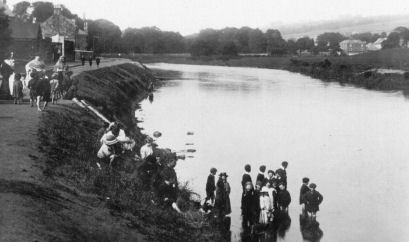
Paddling in the River Leven at Renton (Click to Enlarge)
Renton was, to begin with, the fastest growing village in the Vale - by 1830, for instance, its population was already about 2,000, making it the largest village in the Vale at that time. From the outset, each group of newcomers brought not just their work skills, but also their own social and cultural heritage and aspirations. Since there were more of them and since they came from a diversity of backgrounds, It should be no surprise therefore, that even in the village's early years, Rantonians notched up an impressive succession of “firsts” in the Vale.
The earliest “first” concerned perhaps the biggest popular issue of the day - the question of how the Church of Scotland minister was appointed in each parish. Unquestionably, the vast majority of people wanted a say in the appointment, but patronage had been reintroduced after the Act of Union in 1707. Many congregations rebelled and so-called secessionist churches were set up. It is true that there were also a number of purely theological issues around secession, but most of these were so mind-numbingly complex and boring that its hard to believe they exercised too many people - patronage was the issue and people didn't want the local laird, or the government alone, to make these appointments.
The Church of Scotland was remote from them anyway - over the hill at Cardross - and many Rantonians were no doubt realistic enough to know that nobody on the other side of the hill was going to pay any attention to their opinions, ever. In any event, a great many Rantonians opted for secession and set up the first secessionist church in the Vale in 1786.
 It is also worth noting that this was only the second church of any sort in the Valley, after Bonhill. It stood across the west end of Red Row, earning it the name of “The Red Row Kirk”, and making Red Row a cul-de-sac.
It is also worth noting that this was only the second church of any sort in the Valley, after Bonhill. It stood across the west end of Red Row, earning it the name of “The Red Row Kirk”, and making Red Row a cul-de-sac.
Over the years its congregation went through a whole range of religious sects with long-forgotten names, starting as Associate Burghers, through Auld Licht Burghers (echoes of Holy Willie's Prayer) then Reformed Presbyterian and finally United Free.
The image above is of a communion token from the Reformed Presbyterian Congregation, Renton, Rev. J. McK Minister, 1842.
It operated as a church until well into the 20th century, when it became a metal workshop for a few years before being demolished to make a through road to Hillfoot and Back Street when Hillfoot was built in the 1920's.
Communion tokens were most notably a feature of the Presbyterian Church in Scotland. They were used not only in the Established Church but by the various Secession and Free Churches, the Episcopal Church in Scotland, and occasionally others, such as Methodist and Wesleyan. Scots took the tradition abroad with them, and significant numbers are recorded from Ireland, England, Canada, the USA, Australia, New Zealand and elsewhere.
The original purpose of the tokens was to identify those considered worthy to take part in the communion service, and to prevent those not well instructed in the faith or not of good character from approaching the communion table. In times of persecution, tokens served to exclude strangers and possible spies from the open air conventicles, when this could be a matter of life and death. In the early days, discipline was strict, and celebration of Holy Communion (once or twice a year, but sometimes at much longer intervals) was an important part of life in Scotland. Later the communion season became a great social and religious gathering, continuing from preparatory services as early as Thursday, through to thanksgiving on the Monday. When farm servants in Scotland were engaged they would sometimes bargain for time off to attend.
The kirk session and minister decided who should get the tokens, which were handed out by the minister at the preparatory service or distributed by the elders. On occasion the communion service could last all day, with several ministers serving great numbers at a succession of ‘tables'. Communicants surrendered their tokens usually at the entrance to the table, or when seated, taking their places at the sitting shown by the table number on the token. Table numbers could also indicate different locations in the church when it was possible to seat everyone at once.
There were variations in procedure, and in later times the strictness of the early days was seen as less appropriate, but tokens continued to be used. To be refused one was a matter of great shame in a small community.
Above information is credited to "The First Dictionary of Paranumismatica", Brian Edge 1991)
It is easy now to laugh at the names and theological disputes which lay behind these sects and its unlikely that attendance at them was ever a bundle of laughs, but it is an excellent indication of the strength of independent thinking in Renton from the outset. Indeed it had another Free Church - set up at Millburn in 1843 after the Church of Scotland Disruption of that year - before it got even a Church of Scotland mission, which it did in 1850 (Church of Scotland adherents still had to walk over the hill to Cardross until then).
Millburn Church is worth mention for other reasons too. Firstly, its architect was George Meikle Kemp who also built the Scott monument in Princess Street in Edinburgh - in silhouette the two looked very similar with their “spikey” steeples, until Millburn was allowed to collapse. Since Kemp died before Millburn was finally completed in 1845, it was his last work and is deemed of considerable architectural interest - it has been a Grade A listed building since 1985, but successive councils seem able to ignore this. Secondly, it was Renton's only church-yard (always excluding Alexander Wylie's one-man cemetery in the grounds of Trinity Parish Church). Not only are generations of Rentonians buried there, but also our national bard, Robert Burns, has relatives buried at Millburn.
A third Free Church, the Free Gaelic Church opened in 1856, giving ample proof of the migration from Argyllshire and Loch Lomondside of Gaelic-speaking crofting folk to work in what had now become year-round jobs in the textile industry. It was not until 1870 that a Church of Scotland parish church was opened in what is now Trinity Place in Main Street.
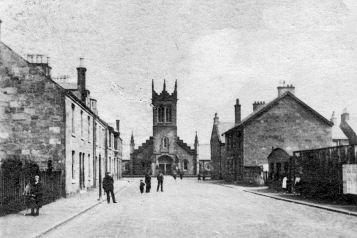
Renton Parish Church (Click to Enlarge)
Clearly, Rentonians of the first half of the 19th century were displaying the same measure of respect for the establishment which twentieth century Rentonians were to display i.e. very little. This detachment from the church at Cardross was important at least until local government was reorganised in 1870, because matters such as education and poor relief were handled on a parochial basis, and “out of sight out of mind” was Cardross's management style for Renton - a bit more benign than the recent Clydebank-centric regime, but only in terms of neglect rather than intention.
History sometimes does repeat itself in Renton, but fortunately the early Rentonians handed lessons down, which can continue to be applied. The next of Renton's “firsts” was a good example of the incomers' influence, and it lay in the area of social development.
In 1788 in a room above the Black Bull Pub, probably then, as later, on the Main Street, the first Masonic Lodge in the Vale was formed, Lodge No 170 Leven St John. 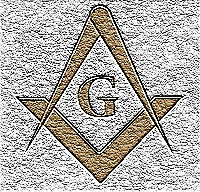 In the chair was David Auchinvole RWM. Freemasonry was particularly strong in the western counties of Scotland in the late 18th century - Burns and his friends provide an excellent record of this. Ayrshire and Renfrewshire were centres of the textile industry then and later, so its very likely that David Auchinvole came to work at Cordale or Dalquhurn from these areas and brought his Masonry with him.
In the chair was David Auchinvole RWM. Freemasonry was particularly strong in the western counties of Scotland in the late 18th century - Burns and his friends provide an excellent record of this. Ayrshire and Renfrewshire were centres of the textile industry then and later, so its very likely that David Auchinvole came to work at Cordale or Dalquhurn from these areas and brought his Masonry with him.
The whole episode tells us quite a lot about Renton's development at the time. It not only had a pub, this pub was in a two-storey building. There are no 18th century two-storey buildings left in Renton, but they were quite identifiable because they were lower than the 19th century buildings that replaced them. The Black Bull which survived until the redevelopment of the 1960's on the corner of Station Street, would have been a replacement for the original, because it was housed in a 19th century building.
The name “Black Bull” denoted that it was a pub used by drovers, so that even in 1788, 30 years or so before the Cattle Fair moved onto Carman Hill, highland drovers were bringing their cattle along Main Street en route to the Glasgow market via Dumbarton Bridge, the only bridge over the Leven at that time. Formal education and informal learning were the next issues to be addressed by the 18th century Rantonians. In 1797 the first Renton school was opened, without any help from Cardross Parish. Jim Murphy in his book locates this school at 124 Back Street. Renton further promoted learning and self-instruction in 1797 by establishing a subscription circulating library. This was not only the first circulating library in the Vale, it was the first such one in the whole of Dunbartonshire. A further indication of the clarity of thought and purpose which lay behind all this, the book were kept in the school, a possibility that seemed to have escaped the Councillors of 2006.
Page 1 | Page 3 | Page 4 | Page 5


